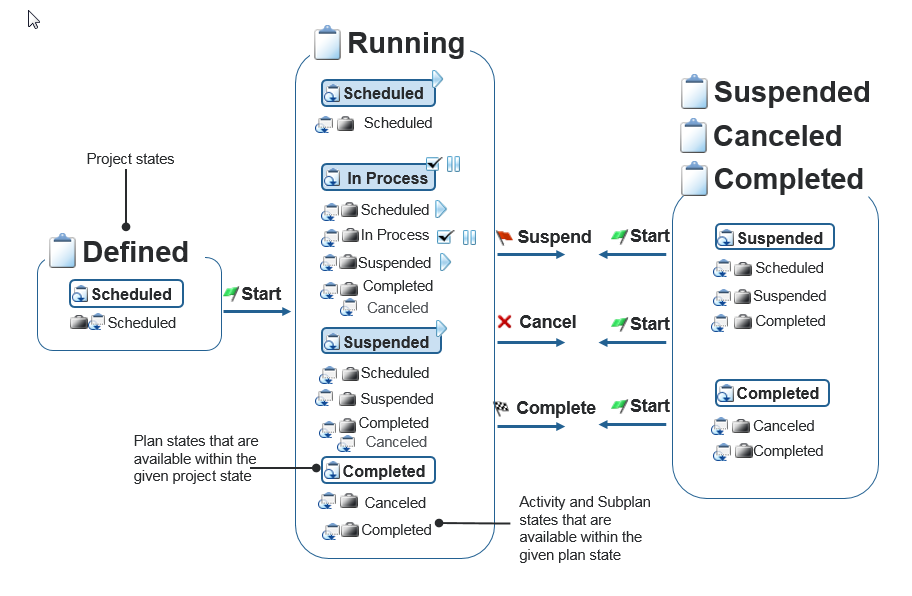|
|
To see the states of individual activities, you can create a custom view in the Schedule table to add a column for the State attribute. For more information, see Creating and Editing New Table Views.
|
|
Project States
|
Plan, Subplan, and Activity States
|
|
Defined
|
Scheduled
|
|
Running
|
In Process
|
|
Suspended
|
Suspended
|
|
Canceled
|
Canceled
|
|
Completed
|
Completed
|
|
|
To see the states of individual activities, you can create a custom view in the Schedule table to add a column for the State attribute. For more information, see Creating and Editing New Table Views.
|


Action | Description | ||||
Initiate automatic execution of the plan.
When you create a new project, you must manually start the plan. Once the plan is started, the first scheduled activity changes from Scheduled to In Process and a notification is sent to the activity owner.
| |||||
Manually start an activity or milestone before its scheduled start date. The Actual Start date is set and any predecessor relationships are removed.
| |||||
Pause execution of the plan or activity. • No activities can be completed and delivery of subsequent tasks is prevented until planning or resource issues are resolved. • When the plan is suspended, activities that are in process move to the Suspended state. You cannot specifically suspend the subplan. • In a suspended autoexecution plan or suspended summary activity, the earliest estimated start date for the created ASAP activity will be the current date and time, depending on the other scheduling constraints. • When the parent plan is suspended, the subplan that is in the state Scheduled, remains scheduled if the referenced plan or activity is in the state Scheduled. Any changes to the referenced plan or activity are rolled up to the subplan. | |||||
Resume plan or activity execution if it has been suspended. You cannot specifically resume the subplans that are rolled up from a referenced plan or activity. When you resume it, all activities that are eligible to start at that time will have the current date and time as the start of those activities. | |||||
Mark the plan or activity as finished. This action cannot be undone. Once a plan or activity is completed, you cannot restart it.
|
Action | Plan State | |||
Scheduled | In Process | Suspended | Completed | |
X | X | |||
X | X | |||
X | X | |||
X | Limited | X | ||
X | Limited | |||
X | X | X | ||
X | X | X | ||
X | X | X | ||
 New Sub-plan New Sub-plan | X | X | X | |
X | X | X | ||
X | X | X | X | |
X | X | X | X | |
X | ||||
X | ||||
X | X | X | X | |
X | X | X | X | |
X | ||||
X | ||||
X | ||||
X | ||||
Action | Activity State | |||
Scheduled | In Process | Suspended | Completed | |
X | Limited | X | ||
X | X | X | ||
X | X | |||
X | X | X | X | |
X | Limited | |||
X | X | X | X | |
X | X | |||
X | X | X | ||
X | Limited | X | ||
X | X | X | X | |
X | X | X | X | |
X | X | X | X | |
Insert Sub-plan Above | X | X | X | X |
Insert Sub-plan Below | X | X | X | X |
Insert Sub-plan as a Child | X | X | X | |
X | X | |||
X | X | |||
X | X | |||
X | X | X | ||
X | ||||
X | ||||
X | ||||
X | ||||
• Execution controls for activities (Start, Suspend, Resume, and Complete) are only available when the plan is in the In Process state. • You cannot edit the Start No Earlier Than date for activities in the Suspended state. • The Track Work action is not available for activity owners when an activity is suspended. Assigned resources can continue to track work, but only the Work, Remaining Work, and Status fields can be edited. |